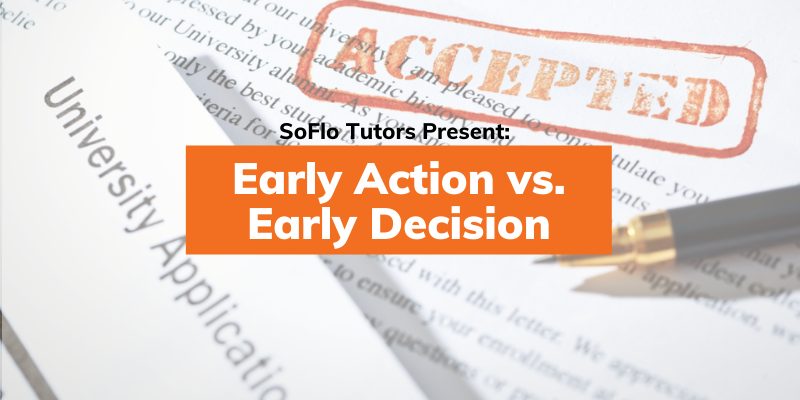
Differences Between Early Action And Early Decision
I’m sure you’ve heard the terms early action and early decision at some point throughout your high school career, especially when starting your college journey and college applications. Both of the terms refer to applying to college early, before the regular decision pool.
It is easy to assume that these two concepts are the same thing, but there’s actually a big difference between the two. This article delves into that difference, as well as important information about applying and schools that accept these early applications.
ED Is Binding While EA Is Non Binding
Both early action (EA) and early decision (ED) are forms of applying to a college before the majority of potential students apply through regular decision. The difference between the two lies in what applicants must do after receiving their decisions: early decision plans are binding while early action plans are non binding.
- A binding plan means that when a student is accepted as an ED applicant, they are required to attend the college — they enter into a binding agreement upon applying.
- A nonbinding plan allows a student more flexibility, as they are not required to commit to the college until the normal admissions process deadline.
It is commonly believed that applying early gives students an upper hand in the application process, as they are competing with fewer applicants in the applicant pool and have a higher chance for acceptance. However, this is not always the case.
Colleges vary in how many students of the incoming class they admit in the early pool versus the regular decision pool. Another factor is that students who apply ED and EA may have very strong profiles, leading to higher acceptance rates for these early applicants. Therefore it cannot be told whether ED and EA applicants have a true advantage. However, applying ED or EA are both great ways of showing demonstrated interest to the universities you apply to.
ED Applicants
Some important information about applying early decision:
- Apply in November to first-choice college
- Apply to only one college ED
- Can apply regular decision to other colleges
- Hear back from colleges usually in December (way before regular decision students)
- Agree to attend the first-choice college if accepted and offered a financial aid package that is acceptable
- Must withdraw from all other colleges if accepted ED
- Send a non-refundable deposit much earlier than regular decision students
EA Applicants
And now for applying early action:
- Apply earlier than regular decision
- Can apply regular decision to other colleges
- Hear back from colleges early in the admission cycle- typically January or February
- Can decide to accept or decline the offer
- Give decision on the national response date of May 1
Who Should Apply Early?
Early admission, either ED or EA, can be very beneficial to students who have a solid idea of where they intend to study after high school — those who have picked out their choice school.
Thus, this is only an option for those who have extensively researched their options and narrowed down the best colleges to their top choice. It is best for students to talk with their school counselor at length before deciding on applying ED or EA, to make sure that they have all of the necessary information.
It is also very important that a student make sure that they match or exceed their top school’s admission profile for things such as SAT and ACT scores, GPA, class rank, and letters of recommendation. Students should be sure to have an academic record that reflects what their top college is looking for.
Apart from academics, potential students must make sure that they are a social fit for their top choice. Looking into what organizations and activities the college provides is very useful in seeing whether a student will fit in with the campus culture.
Who Should Not Apply Early?
Applying early is not the best choice for every student, so students that fall into the following categories should not consider ED or EA, but rather the regular decision pool.
Students should not apply early if they:
- Have not researched colleges
- Are applying to avoid stress and lots of applications
- Are not fully committed to attending the college (it should be your dream school!)
- Are applying only because of friends or family
- Have an inconsistent academic record
Benefits Of Applying ED Or EA
Applying ED or EA to a first-choice school has many benefits, apart from possibly increasing a student’s chances of acceptance. These benefits include:
- Not having to worry about multiple applications
- Less time having to wait for a decision
- More time to prepare for college once accepted
- Ability to reassess options and apply elsewhere through regular decision if not accepted
Will ED Affect Financial Aid?
For students who require financial aid, applying early decision could be risky. This is because students will be unable to compare financial aid offers across schools, so while they may be accepted early to their top-choice school, they may not receive the best financial aid package and may therefore end up spending more for their education.
For this reason, it is commonly thought that ED has an unfair advantage to those students from more financially-stable families. However, it is important to note that if students are not offered a doable financial aid package, they are able to reject their offer of admission to their ED school. Students applying EA have a better opportunity to compare financial aid offers from multiple schools.
Drawbacks To Applying Early
We already talked about the reduced financial aid opportunities, but what are the other drawbacks to an early action or early decision application?
Time Crunch (If Rejected)
Students typically hear admission decisions from their ED and EA applications on December 15th. The usual deadline for regular decision applications comes soon after this, so if a student is rejected from their ED or EA school, then they will have reduced time to complete their applications to other schools. Therefore it is important that a student prepare for all scenarios and begin all applications in enough time for early and regular admission.
Decision Pressure
Making the choice to apply to one college and then commit to going there if accepted is a huge decision! This may be very stressful for students who would wish to explore more options.
Senioritis
This is a real thing. And it is dangerous! Students who have been accepted early into a college may feel no more motivation to continue their hard work throughout their senior year, possibly leading to a lack of participation or a drop in grades. Students must be aware, however, that colleges are able to rescind offers of admission based on test scores and senior grades, so it is best to avoid senioritis and stay motivated!
ED And EA Application Deadlines
Okay so we’ve covered most of the basics so far: now what about early action and early decision deadlines? When exactly should you be starting these applications and when will you hear back?
Because ED and EA involve admission plans to a first-choice school, students should begin their research into higher education early, perhaps even before the beginning of junior year. It is important to take your time and thoroughly search through colleges and determine where is the best fit.
Students should also gather their application materials well in advance of the typical November 1st deadline. Ask for recommendation letters before or by October 1st, and be sure to have your SAT and ACT test scores ready to send.
Also, be sure to request an official transcript from your school counselor, as that is a crucial piece of your application! Most importantly: begin your essays over the summer before senior year. Give yourself ample time to write, draft, revise, and revise again. Spend the rest of your senior fall perfecting your application for that November 1st deadline.
Once you’ve applied EA or ED, you will hear back mid-December, giving you a huge leg up on those who are still completing their regular admission applications. However, this does mean that you must respond to the admission offer faster (in the case of ED — EA has the luxury until the regular May 1st date).
Do All Schools Offer EA And ED?
A good number of colleges, around 450, offer early decision or early action admission plans, some offering both. There is another option that some schools employ called single-choice early action, under which applicants may not apply either ED or EA to any other institution of higher education. It is important when researching colleges to see all of the choices they offer and what option works best for you.
Boston College
Boston College offers either early decision or regular decision for incoming applicants. In the latest decision pool, about 39% of ED applicants were accepted, making up 48% of the incoming freshman class.
Brown
Brown also has an early decision option for applicants. Students can either be accepted ED, rejected from admissions wholly, or deferred to the regular decision pool.
Dartmouth
Early decision is offered at Dartmouth along with regular decision. Like the above two schools, there does not appear to be an early action option for applicants. For the applying class of 2026, there was a 21% admission rate for ED applicants,
Harvard
Harvard offers EA for applicants, but not an ED option. In the most recent EA applicant pool, about 8% of students were accepted, while still having the flexibility to deny this offer because of the early action status instead of early decision.
Princeton
Similar to Harvard, Princeton does not offer ED for applicants, but rather extends a single-choice EA for those students wishing to apply early. Their application deadline for this early admission is November 9th. Students that do not consider Princeton their top choice can apply through regular decision.
Stanford
Stanford offers two options for applicants: regular decision and restrictive early action. This REA is nonbinding, and can have three decision outcomes: admission, rejection, or deferment to regular decision.
Vanderbilt
Vanderbilt offers two rounds of ED, both being binding options, the only difference lying in the deadlines for applicants. This school does not offer EA, so students applying early must have Vanderbilt as their top choice.
Yale
Like most of the schools listed here, Yale offers only one type of early decision plan: restrictive/single-choice early action. The biggest benefit of this program is the flexibility to apply to other schools and ultimately compare financial aid packages before committing to Yale, which could draw motivated students to apply early here.
Get Ready To Apply Early With SoFlo Tutors
Here at SoFlo tutoring, high-scoring students from top schools are just a click away from helping you boost your test scores and prepare you for the road to applying early to your dream school. Our tutors help students raise their SAT and ACT scores, feel more confident in their testing abilities, and give excellent advice on the college search journey. Try out our services today so you can get into the school of your dreams.
Sources
- Boston College: https://www.bc.edu/content/bc-web/admission/apply/early-decision.html
- Brown: https://admission.brown.edu/first-year/early-decision
- Dartmouth: https://admissions.dartmouth.edu/glossary-term/early-decision
- Harvard: https://college.harvard.edu/admissions/apply/first-year-applicants
- Princeton: https://admission.princeton.edu/how-apply/application-dates-deadlines/single-choice-early-action
- Stanford: https://admission.stanford.edu/apply/deadlines/
- Vanderbilt: https://admissions.vanderbilt.edu/vandybloggers/2013/08/early-action-early-decision-and-regular-decision-whats-the-difference/
- Yale: https://admissions.yale.edu/single-choice-early-action
About the Author

Keli Pegula is a sophomore at Dartmouth on the Pre–Med track. She’s a SoFlo tutor who scored 1480 on her SATs and 34 on her ACTs. When she’s not at school in Hanover, she might be in her hometown of Scranton, Pennsylvania — the town where the iconic TV show The Office is set!









